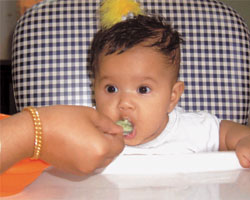You give baby his favourite toy, but he just keeps fussing and tries to gnaw on its leg.You wonder if he could be hungry again, even though you’ve just nursed him.
It sounds like your six-month-old baby is ready for more than just breast milk. This is the stage called complementary feeding (or weaning) where you introduce semi-solid and solid foods to baby.
Start giving complementary foods to baby at 4-6 months of age. These foods will help provide energy and nutrients that he needs through the next stage of growth and development.
The foods introduced during this period will have an impact on his eating habits as he grows up. Let him try a variety of foods so that he learns to enjoy many different tastes!
Here are some simple guidelines to follow when preparing and giving complementary foods:
- Introduce new foods in small amounts, one at a time. Start with small amounts of food (offer just one or two spoonfuls at first).
- Do not add salt, sugar or oil to the foods.
- If baby rejects a new food, don’t force it on him. Just try giving it again later.
- Allow 3-5 days after each new food is introduced before giving a new one. This helps pinpoint allergies should they occur.
- As new foods are introduced, remember to continue offering the earlier foods.
- At 6-8 months and onwards, start combining different foods.
- Slowly increase the quantity of foods given to baby as he gets older.
- Incorporate meat, poultry, fish or eggs into baby’s diet daily, or as often as possible.
- Feed baby slowly and patiently; do not force-feed.
- Give foods that are appropriate for baby’s age. Do not give nuts or seeds that he may choke on.
- Talk to, and maintain eye contact with, baby during feeding.
- Maintain breastfeeding and mix breast milk with other foods whenever appropriate.
If you are leaving baby in the care of your maid or a caregiver (such as a babysitter, your parents or parentsin- law), share this information with them as well.
FIRST FOODS
Porridge, porridge and more porridge! Have you run out of ideas on what to feed baby? Use the list below as a guide:
- At 6 months: Give baby a small taste after breastfeeding
- Ready-to-eat iron-fortified infant cereals
- Rice, oat or barley porridge
- Single, pureed fruits like banana, papaya, apple, pear
- Single, strained (diluted) fruit juice
- 6-8 months: Feed 2-3 times a day
- Rice porridge with mashed vegetables, tofu, finely ground ikan bilis (anchovies) or mashed egg yolk
- Mashed or finely chopped fruits
- Softened or mashed vegetables like carrots, peas, tomatoes and green leafy vegetables
- Chopped or mashed liver, chicken and fish (introduce these foods one at a time and remember to remove the bones beforehand!)
- 8-12 months: Feed 3-4 times a day before breastfeeding
- Soft fruits that have been cut into tiny bite-size pieces
- Strained (undiluted) fruit juice
- Chopped vegetables, including green leafy vegetables
- Rice porridge with minced or finely chopped meat and fish
- 12 months and above: Feed 1-2 times a day, with nutritious snacks added
- Soft cooked rice and noodles (including koay teow, mee hoon and mee) that have been cut into short pieces
- Wheat cereals and soft bread (observe if any allergies arise)
- Cooked egg white (observe if any allergies arise)
- Soft fruits that have been cut into small bite-size pieces
- Strained (undiluted) fruit juice
- Chopped vegetables, including green leafy vegetables
- When baby is ill
- Breastfeed more frequently
- Give soft, appetising foods that baby likes
- Encourage baby to eat more until he regains any weight lost
IS COMMERCIAL BABY FOOD OK?
If you are working, busy with house chores or have to travel longdistances, commercial baby foods can come in handy.
The most popular types of commercial foods are the ready-toeat rice, oatmeal or barley cereals, and all-in-one cereals that also contain vegetables or fruits.You can buy pureed fruits and vegetables, and commercial fruit juices as well.
Check the label on the packaging to make sure that it contains no artificial additives, flavourings, colourings, added salt or sugar. When buying fruit juice, choose 100% juice with no added sugar.
However convenient they are, commercial foods are limited in their variety, and may not expose baby to delicious local tastes. Continue to give baby complementary food that’s prepared by hand whenever you can. As they say, mum’s cooking is the best!






Comments